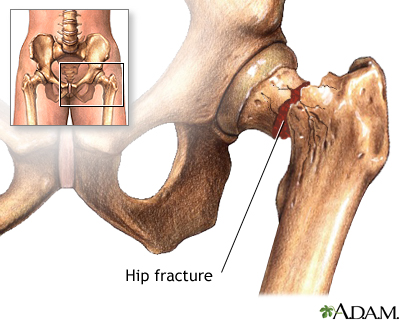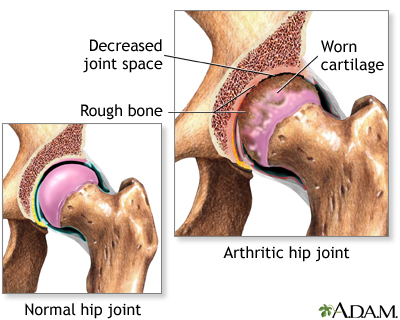Health Library
Hip pain
Pain - hip
Hip pain involves any pain in or around the hip joint. You may not feel pain from your hip directly over the hip area. You may feel it in your groin or pain in your thigh or knee.
Images


I Would Like to Learn About:
Causes
Hip pain may be caused by problems in the bones or cartilage of your hip, including:
- Hip fractures -- can cause sudden and acute hip pain. These injuries can be serious and lead to major problems. It is more common in older patients because their bones can be weaker.
- Infection in the bones or joints.
- Osteonecrosis of the hip (necrosis from loss of blood supply to the bone).
- Arthritis -- often felt in the front part of the thigh or groin.
- Labral tear of the hip.
- Femoral acetabular impingement -- abnormal growth around your hip that is a precursor to hip arthritis. It can cause pain with movement and exercise.
Pain in or around the hip may also be caused by problems such as:
- Bursitis -- pain when getting up from a chair, walking, climbing stairs, and driving
- Hamstring strain
- Iliotibial band syndrome
- Hip flexor strain
- Hip impingement syndrome
- Groin strain
- Snapping hip syndrome
Pain you feel in the hip may reflect a problem in your back, rather than in the hip itself. Pain due to problems in the hip joint itself is often felt most in the groin.
Home Care
Steps you can do to lessen hip pain include:
- Try to avoid activities that make pain worse.
- Take over-the-counter pain medicines, such as ibuprofen or acetaminophen.
- Sleep on the side of your body that does not have pain. Put a pillow between your legs.
- Lose weight if you are overweight. Ask your health care provider for help.
- Try not to stand for long periods of time. If you must stand, do so on a soft, cushioned surface. Stand with an equal amount of weight on each leg.
- Wear flat shoes that are cushioned and comfortable.
Things you can do to avoid hip pain related to overuse or physical activity include:
- Always warm up before exercising and cool down afterward. Stretch your quadriceps and hamstrings.
- Avoid running straight down hills. Walk down instead.
- For exercise, swim instead of running or biking.
- Run on a smooth, soft surface, such as a track. Avoid running on cement.
- If you have flat feet, try special shoe inserts and arch supports (orthotics).
- Make sure your running shoes are made well, fit well, and have good cushioning.
- Cut down the amount of exercise you do.
See your provider before exercising your hip if you think you may have arthritis or have injured your hip.
When to Contact a Medical Professional
Go to a hospital or get emergency help if:
- Your hip pain is acute and caused by a serious fall or other injury.
- Your leg is deformed, badly bruised, or bleeding.
- You are unable to move your hip or bear any weight on your leg.
Contact your provider if:
- Your hip is still painful after 1 week of home treatment.
- You also have a fever or rash.
- You have sudden hip pain, plus sickle cell anemia or long-term steroid use.
- You have pain in both hips and other joints.
- You start limping and have difficulty with stairs and gait.
What to Expect at Your Office Visit
Your provider will perform a physical exam with careful attention to your hips, thighs, back, and the way you walk. To help diagnose the cause of the problem, your provider will ask questions about:
- Where you feel the pain
- When and how the pain started
- Things that make the pain worse
- What you have done to relieve the pain
- Your ability to walk and support weight
- Other medical problems you have
- Medicines you take
You may need x-rays of your hip or an MRI scan.
Your provider may tell you to take a higher dose of over-the-counter medicine. You may also need a prescription anti-inflammatory medicine.
Related Information
Hip joint replacementHip fracture surgery
Hip fracture - discharge
Hip replacement - discharge
Hip or knee replacement - after - what to ask your doctor
Hip or knee replacement - before - what to ask your doctor
References
Chen AW, Domb BG. Hip diagnosis and decision-making. In: Miller MD, Thompson SR, eds. DeLee, Drez, & Miller's Orthopaedic Sports Medicine. 5th ed. Philadelphia, PA: Elsevier; 2020:chap 77.
Guyton BJ. Hip pain in the young adult and hip preservation surgery. In: Azar FM, Beaty JH, eds. Campbell's Operative Orthopaedics. 14th ed. Philadelphia, PA: Elsevier; 2021:chap 6.
Huddleston JI, Goodman S. Hip and knee pain. In: Firestein GS, Budd RC, Gabriel SE, Koretzsky GA, McInnes IB, O'Dell JR, eds. Firestein and Kelly's Textbook of Rheumatology. 11th ed. Philadelphia, PA: Elsevier; 2021:chap 51.
BACK TO TOPReview Date: 4/24/2023
Reviewed By: C. Benjamin Ma, MD, Professor, Chief, Sports Medicine and Shoulder Service, UCSF Department of Orthopaedic Surgery, San Francisco, CA. Also reviewed by David C. Dugdale, MD, Medical Director, Brenda Conaway, Editorial Director, and the A.D.A.M. Editorial team.
 | A.D.A.M., Inc. is accredited by URAC, for Health Content Provider (www.urac.org). URAC's accreditation program is an independent audit to verify that A.D.A.M. follows rigorous standards of quality and accountability. A.D.A.M. is among the first to achieve this important distinction for online health information and services. Learn more about A.D.A.M.'s editorial policy, editorial process and privacy policy. A.D.A.M. is also a founding member of Hi-Ethics. This site complies with the HONcode standard for trustworthy health information: verify here. |
The information provided herein should not be used during any medical emergency or for the diagnosis or treatment of any medical condition. A licensed medical professional should be consulted for diagnosis and treatment of any and all medical conditions. Links to other sites are provided for information only -- they do not constitute endorsements of those other sites. No warranty of any kind, either expressed or implied, is made as to the accuracy, reliability, timeliness, or correctness of any translations made by a third-party service of the information provided herein into any other language. © 1997- 2024 A.D.A.M., a business unit of Ebix, Inc. Any duplication or distribution of the information contained herein is strictly prohibited.
